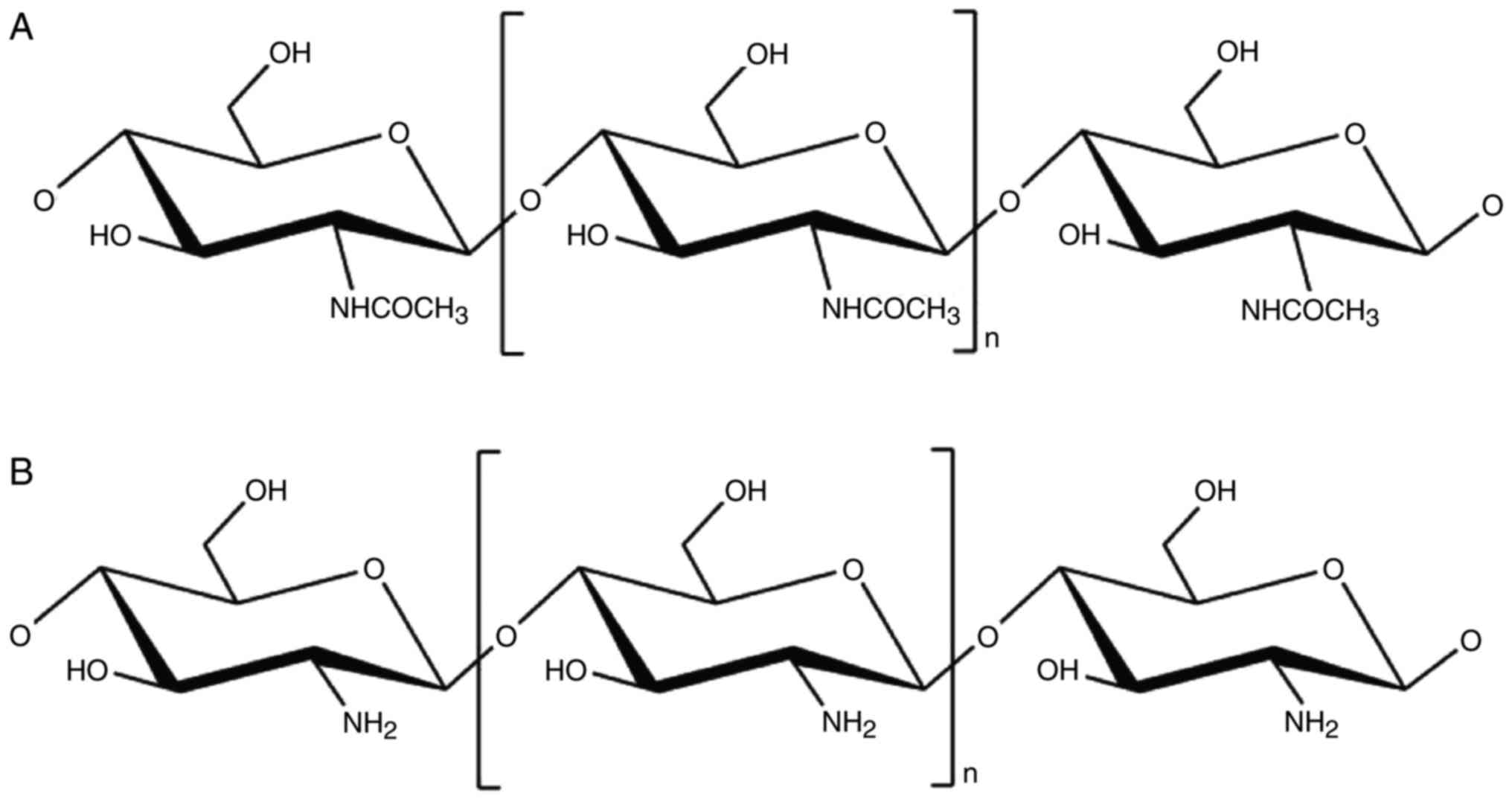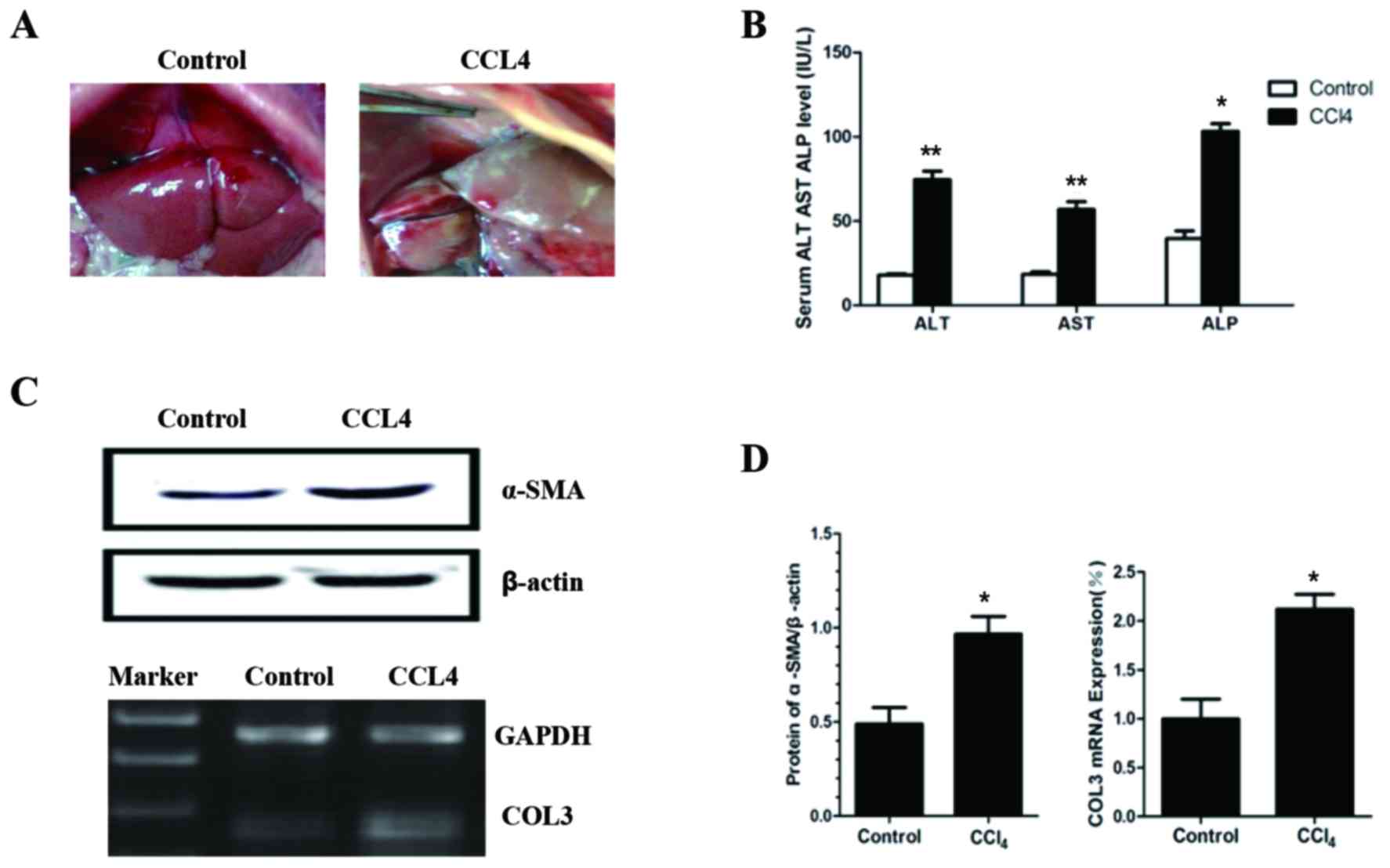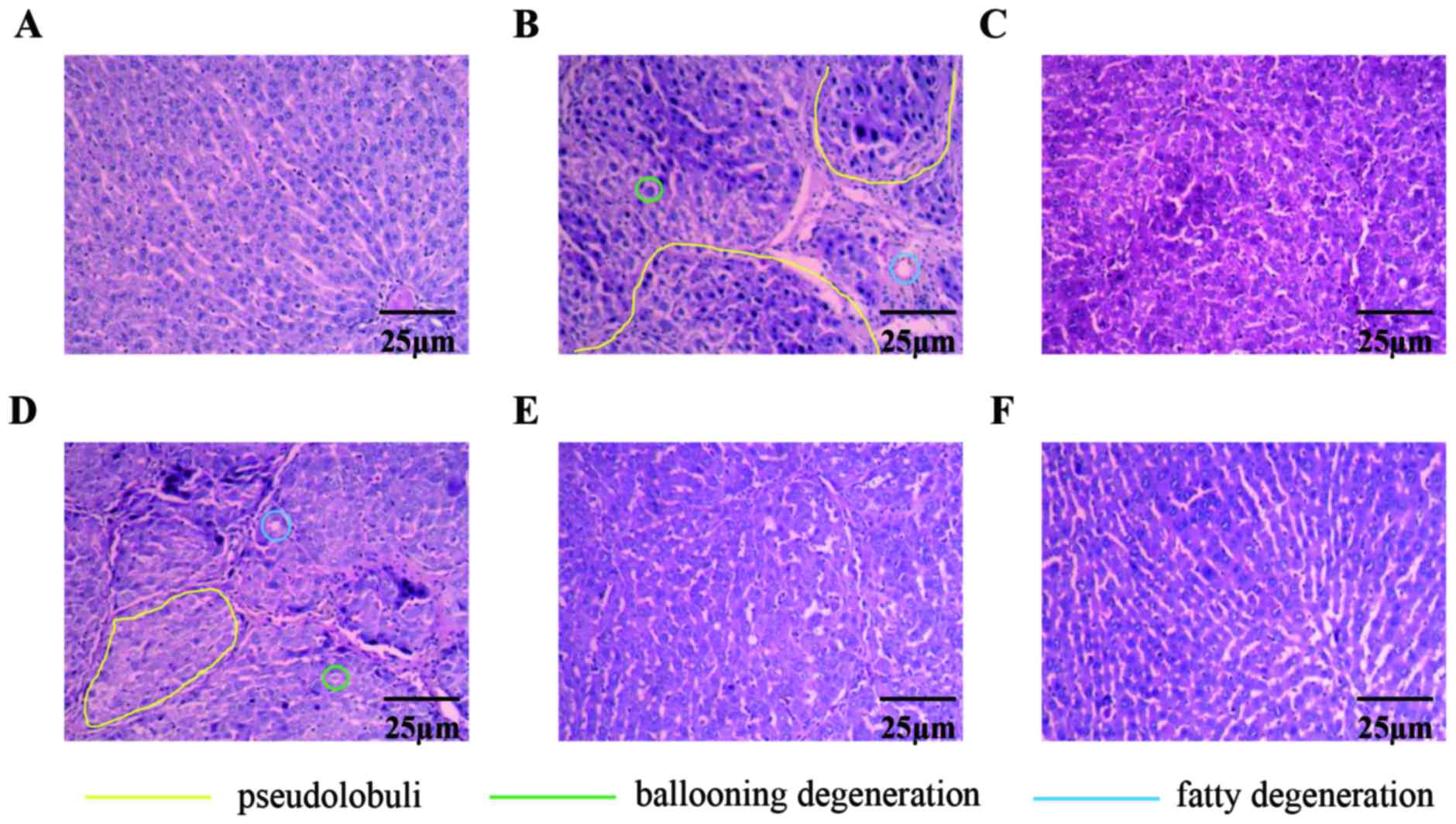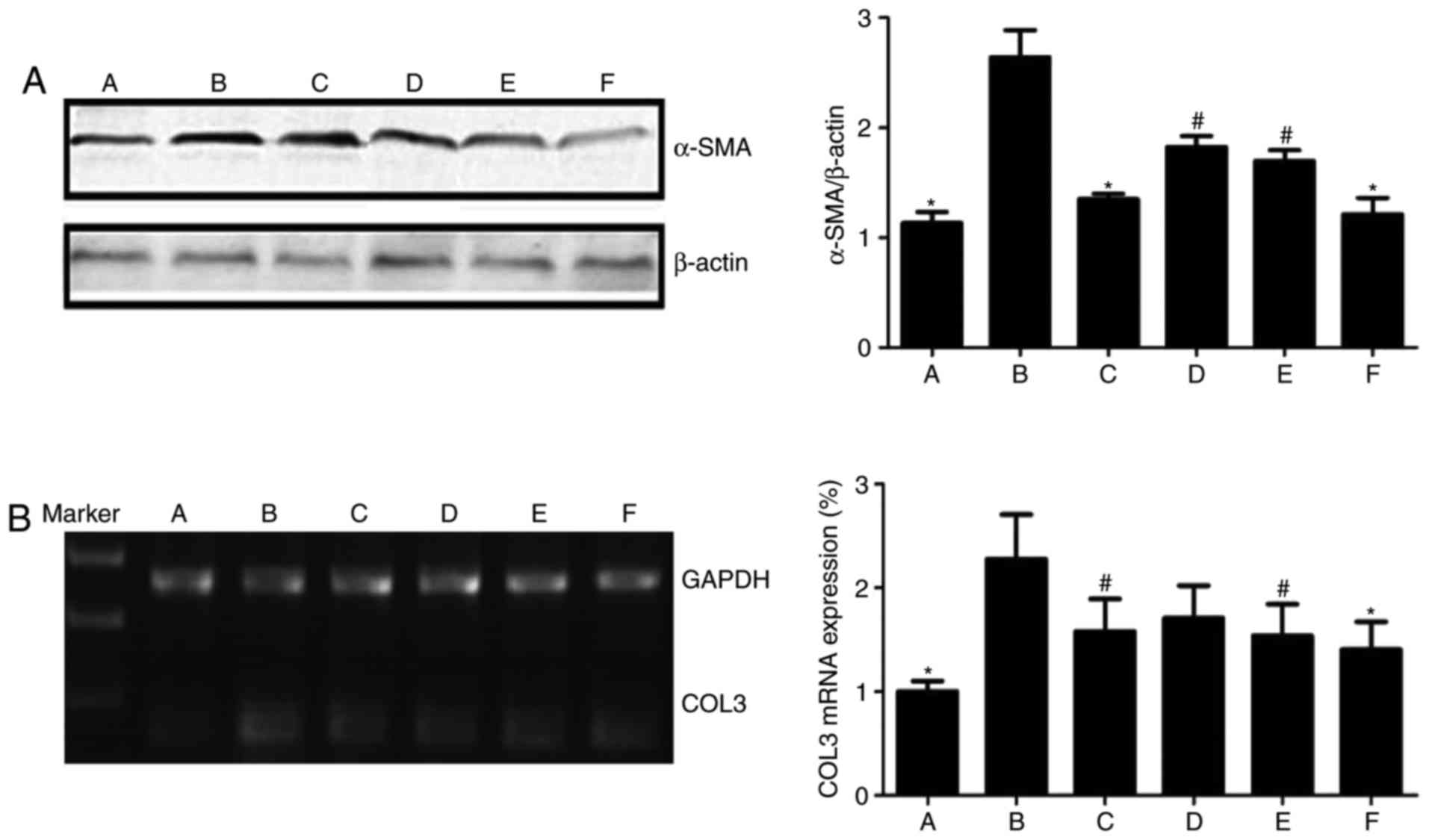Introduction
Chitin, poly-β-(1–4)-N-acetyl-D-glucosamine, is the most
abundant natural amino polysaccharide and its annual production is
estimated to almost equal that of cellulose (1). The principal sources of chitin are
two marine crustaceans, shrimp and crab. Chitosan is a well-known
N-deacetylated derivative of chitin, although this N-deacetylation
is almost never complete. There is great interest in examining the
potential therapeutic effects of chitosan on hepatic fibrosis (HF),
as chitin and its derivatives have been reported to have a wide
range of medical applications (2–4). It
has been suggested that chitosan inhibits fibroplasia in wound
healing, and promotes tissue growth and differentiation in
vitro (5,6). Notably, chitosan has
anti-inflammatory and anti-oxidative properties (7–9).
Carbon tetrachloride (CCl4) is an
established hepatotoxin. It is thought to require activation by
hepatic microsomal mixed-function oxidase to form the
trichloromethyl free radical, CCl3·. This, in turn,
reacts with oxygen to form the more reactive trichloromethylperoxyl
radical, CCl3OO·. CCl3OO· interacts with
polyunsaturated fatty acids to cause lipid peroxidation, whereas
CCl3· binds to lipids and protein components of the
membrane leading to covalent binding. CCl3OO· causes
severe cell injury, stimulating inflammation and fibroblasts
(10–13).
Liver fibrosis results from chronic liver damage in
conjunction with the accumulation of extracellular matrix (ECM)
proteins, which consist predominantly of collagen (COL) 1 and COL3.
The primary causes of liver fibrosis include chronic hepatitis C
virus infection, alcohol abuse and non-alcoholic steatohepatitis.
Accumulation of ECM proteins distorts the hepatic architecture by
forming a fibrous scar and leads to cirrhosis, which is defined by
the subsequent development of regenerating hepatocyte nodules.
During this period, oxidative stress serves an important role, as
this stimulus may liberate mediators of cytokines and assist in the
activation of hepatic stellate cells (HSCs), which are the
predominant collagen-producing fibrogenic cell type in the liver
(14–17). Cirrhosis causes hepatocellular
dysfunction and increased intrahepatic resistance to blood flow,
resulting in hepatic insufficiency and portal hypertension,
respectively (18–20). There are currently no effective
treatments for liver fibrosis; therefore, it was hypothesized that
chitosan may have a therapeutic effect on CCl4-induced
HF in rats. To test this hypothesis, the effect of treatment with
chitosan on HF in the rats was evaluated by determining the
production of aspartate transaminase (AST), alkaline phosphatase
(ALP) and alanine transaminase (ALT); assessing histological
features; and detecting the relative gene expression levels of COL3
and the protein expression levels of α-smooth muscle actin
(SMA).
Materials and methods
Reagents
Chitosan (98% purity, by high-performance liquid
chromatography analysis) was purchased from Shandong Jinan Haidebei
Marine Bioengineering Co., Ltd. (Shandong, China) and the chemical
structure is presented in Fig. 1.
CCl4, xylene, alcohol, chloral hydrate and formaldehyde
were purchased from Beijing Chemical Factory (Beijing, China). ALT
(cat. no. A7526), ALP (cat. no. A7516) and AST (cat. no. A7561)
Elisa kits were purchased from Pointe Scientific, Inc. (Canton, MI,
USA). Anti-AST antibody (cat. no. AV43932), anti-α-SMA antibody
(cat. no. A2547), secondary antibodies were purchased from
Sigma-Aldrich (Merck KGaA, Darmstadt, Germany). Anti-β-actin was
purchased from Abcam (cat. no. ab8227, Cambridge, UK).
Poly-L-lysine and radioimmunoprecipitation assay (RIPA) lysis
buffer were purchased from DGCS-Biology Technology, Inc. (cat. no.
9806; Nanjing, China). The enhanced chemiluminescent western
blotting kit was purchased from GE Healthcare (Chicago, IL,
USA).
Animal experiments
The present study was approved by the medical ethics
committee of The First Hospital of Jilin University (Changchun,
China). Male Sprague-Dawley (SD) rats aged 8 weeks, weighing 190±10
g, were purchased from the Laboratory Research Center of Jilin
University (certificate no. 2000-042; Changchun, China). All
animals were housed under standard laboratory conditions. Rats were
fed and housed in groups in plastic-bottomed cages containing
sawdust. Animals were bred in a temperature-controlled environment
(25±2°C) with lighting between 6:00 a.m. and 6:00 p.m. From a total
of 72 SD male rats, 16 were randomly selected as the control group
and the remaining 56 were used as the CCl4 treatment
groups. Rats in the control group received intraperitoneal
injections of olive oil (1.75 ml/kg) 3 times a week and for 7
weeks. The CCl4 group rats received intraperitoneal
injections of CCl4 and an olive oil mixture (1.75 ml/kg)
3 times a week and for 7 weeks (CCl4:olive oil=4:6) to
induce liver fibrosis. After 7 weeks, 6 rats in the control group
and 6 rats in the CCl4 treatment group were sacrificed
randomly for morphometric analysis of liver tissue; to measure the
serum levels of ALT, AST, and ALP; to quantify the expression
levels of the COL3 gene and α-SMA protein in the liver tissue; and
to assess the establishment of the HF model. The remaining 50 rats
in the CCl4 group were randomly divided into five groups
(n=10): The HF group; glycyrrhizinate group; low-dose chitosan
group (2.5 mg/kg); middle-dose chitosan group (5.0 mg/kg); and
high-dose chitosan group (10.0 mg/kg). Subsequently, the six groups
were unified by a continuous administration of daily tail vein
injections for 28 days. Control groups and HF groups were
administered normal saline; glycyrrhizinate and chitosan groups
were administered the corresponding regents. Blood was collected
from the inner canthus vein on days 7, 14, 21 and 28 to detect the
ALT, AST and ALP levels. On day 28, rats were anesthetized via an
intraperitoneal injection of 10% chloral hydrate (300 mg/kg) and
sacrificed by heart puncture for blood extraction. Subsequently,
the abdominal cavity was opened using a U-shaped incision; the rat
liver was harvested, cut into two uniform blocks, washed with
saline and dried with filter paper. A piece of liver tissue was
fixed in 10% formalin at 4°C for 24 hours for morphometric
analysis, whilst the other piece was wrapped in foil and stored in
liquid nitrogen for western blot analysis. Following 7 days of
fixation, the fixed liver tissues were embedded in paraffin for
sectioning.
Measurement of organ injury
markers
Serum levels of AST, ALT and ALP were measured using
commercial assay kits, according to the manufacturer's
protocols.
Morphometric analysis
Livers were fixed in 10% neutral buffered formalin.
The fixed tissues were dehydrated through an ascending alcohol
series (70, 80, 90 and 100% v/v) and paraffinized in benzene, prior
to being embedded in paraffin. Paraffin sections (5 µm) were cut
using a microtome for hematoxylin and eosin (H&E) staining to
evaluate liver injury. In brief, the paraffin sections were stained
with hematoxylin for 5 mins at room temperature, then washed in
running water for 5 mins. Following immersion in 1% hydrochloric
acid for 30 sec, the sections were stained with 0.5% eosin. The
extent of HF in each sample was assessed based on the scoring
criteria presented in Table I.
This grading system was proposed by Brunt et al in 1999 for
scoring fibrosis (21). A modified
non-alcoholic fatty liver disease fibrosis score (22) was used for scoring inflammatory
lesions.
 | Table I.Histological scoring of fibrosis. |
Table I.
Histological scoring of fibrosis.
| Score | Fibrosis | Inflammatory
lesion |
|---|
| 0 | None | None |
| 1 | Limited to central
veins | 1 lesion per ×100
field |
| 2 | Extended to Glisson's
capsules | 2–4 lesions per ×100
field |
| 3 | Bridging
fibrosis | 2–4 lesions per
×200 field |
| 4 | Nodular
transformation | >5 lesions per
×200 field |
Western blot analysis
Liver tissue lysates were prepared by homogenizing
liver samples in RIPA buffer. The supernatant was transferred into
a 1.5-ml Eppendorf tube, kept at 4°C in the refrigerator for 40 min
and centrifuged at room temperature for 10 min at 12,000 × g.
Protein concentration in the supernatants were measured using a
Bradford protein assay according to the manufacturer's protocol. A
total of 50 µg protein per sample was separated by 10% SDS-PAGE and
transferred onto a nitrocellulose membrane. The membranes were
blocked for 2 h in PBS containing 10% non-fat dried milk and 0.1%
Tween 20. Subsequently, membranes were incubated at 37°C for 1 h
with anti-α-SMA (1:200) or anti-β-actin (1:40,000) antibodies in
PBS containing 5% milk, and then incubated with the goat anti-rat
secondary antibody (1:2,000) at room temperature for 2 h. Following
washing, the membranes were visualized using the enhanced
chemiluminescent western blot kit and densitometric analysis was
performed using Image J version 1.44 (National Institutes of
Health, Bethesda, MD, USA).
Reverse transcription-semiquantitative
polymerase chain reaction (RT-sqPCR)
Total RNA was extracted from liver tissues using the
TRIzol® reagent (Thermo Fisher Scientific, Inc.,
Waltham, MA, USA), according to the manufacturer's protocol. A
total of 2 µg RNA was reverse transcribed to complementary (c)DNA
at 37°C for 15 min and at 85°C for 5 seconds using random hexamers
and the SuperScript™ III First-Strand Synthesis system (Invitrogen;
Thermo Fisher Scientific, Inc.). cDNA was PCR-amplified in tandem
using specific primers for COL3 and GAPDH, and Taq polymerase (cat.
no. EP0402; Thermo Fisher Scientific, Inc.). The primer sequences
were as follows: COL3 (169 bp product), forward
5′-AACCCTGCTCGGAATTGCAG-3′, reverse 5′-TCTGTCCACCAGTGCTTCCG-3′;
GAPDH (687 bp product), forward 5′-GGGTGATGCTGGTGCTGAGTATGT-3′,
reverse 5′-AAGAATGGGAGTTGCTGTTGAAGT-3′. Amplification was performed
for 30 cycles with a denaturation temperature of 94°C, annealing
temperature of 58°C and extension temperature of 74°C for COL3 and
GAPDH in a thermal cycler (Veriti; Thermo Fisher Scientific, Inc.).
PCR products were verified on 1.2% agarose gels and visualized
under UV following ethidium bromide staining. Band intensities were
analyzed using the Image Master Total Lab image analysis software
version 2.01 (Nonlinear Dynamics, Ltd., Newcastle upon Tyne, UK).
GAPDH was used as an internal control to normalize target gene
expression.
Statistical analysis
All data were analyzed and assessed for significance
using the Pearson omnibus normality test. All data are presented as
the mean ± standard error of the mean. The significance between
experimental groups and control group was determined by Dunnett-t
test using SPSS version≈20.0 (IBM Corp., Armonk, NY, USA).
P<0.05 was considered to indicate a statistically significant
difference.
Results
Treatment with CCl4 induces
liver fibrosis in rats
Rat livers were visually assessed to evaluate
morphological alterations following treatment with CCl4.
As presented in Fig. 2A, the
livers from rats treated with CCl4 (right) became pale,
hard, rough, shrunken and thick, indicating serious liver injury,
compared with the control group (left). The serum levels of ALT,
AST and ALP in the CCl4-treated group were three- to
four-fold higher compared with in the control group (P<0.05),
demonstrating that the rat model of liver fibrosis was successfully
established (Fig. 2B). In
addition, the expression levels of α-SMA and COL3 in liver tissues
were evaluated using western blotting and RT-sqPCR, respectively
(Fig. 2C). The expression levels
of the α-SMA protein and COL3 gene in the CCl4-treated
group were approximately two-fold higher compared with the control
group (P<0.05; Fig. 2D),
indicating HSC activation and liver fibrosis.
Effect of treatment with chitosan on
liver enzymes in rats with HF
The physical status of rats in the different
treatment groups was recorded. Rats in the control group were
healthy and active, and had glossy, smooth coats with bright eyes.
Conversely, HF rats exhibited dull eyes, swollen paws, slow
movement, decreased food intake, unkempt back hair, trichomadesis
and hard abdominal swelling. Rats treated with chitosan or
glycyrrhizinate increased their food intake, and edema and
trichomadesis were reduced. Following 7 days of treatment with
chitosan, there was a significant reduction in ALT, AST and ALP
enzymes compared with the HF group (Fig. 3). The recovery of rats in the
middle- and high-dose chitosan treatment groups was also better
compared with the low-dose chitosan treatment group. In addition,
the effect of treatment with chitosan was dependent on the duration
of administration, with improved recovery occurring after 21 days
of treatment.
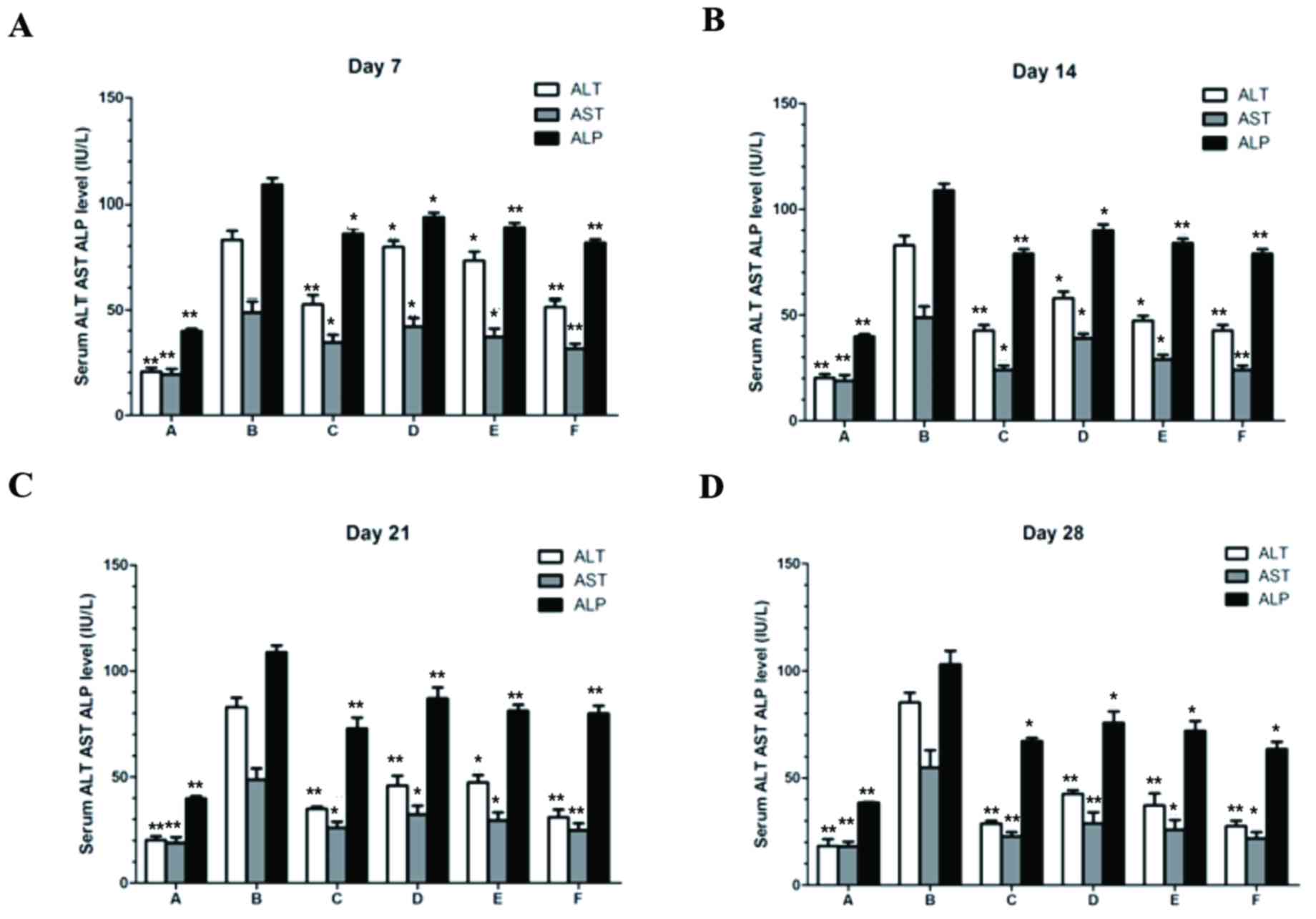 | Figure 3.Serum levels of ALT, AST and ALP in
the different experimental groups. Serum levels were measured
following (A) 7, (B) 14, (C) 21 and (D) 28 days of treatment. Group
A, control group; group B, hepatic fibrosis; group C,
glycyrrhizinate; group D, 2.5 mg/kg chitosan; group E, 5 mg/kg
chitosan; and group F, 10 mg/kg chitosan. *P<0.05 and
**P<0.01 vs. group B. ALP, alkaline phosphatase; ALT, alanine
transaminase; AST, aspartate transaminase. |
Effect of treatment with chitosan on
liver histology in rats with HF
The liver tissue from rats in the HF group exhibited
serious liver injury, as identified by substantial macrosteatosis,
hepatocellular ballooning, transparent cytoplasm and nuclei being
pushed to the side, suggesting cellular necrosis. In addition,
pseudolobuli were visible, which are characteristic structures of
HF. In the glycyrrhizinate group, inflammation was markedly reduced
and the pseudolobule was not visible; however, ballooning
degeneration and fatty degeneration remained. The low-dose chitosan
group exhibited obvious pseudolobule formation and alveolar
inflammatory cell infiltration. Treatment with middle-dose chitosan
produced similar results to the glycyrrhizinate group. The
high-dose chitosan group had the best outcome, with liver tissues
exhibiting no signs of pseudolobules, ballooning degeneration or
fatty degeneration. The functional status of the high-dose group
improved rapidly. The other groups exhibited certain improvements,
although their overall recovery was worse compared with the
high-dose chitosan group (Fig. 4
and Table II). These results
indicated that chitosan reduced hepatocellular damage and improved
liver function in HF rats, with the highest dose having the best
treatment effect.
 | Table II.Degree of liver fibrosis in each
treatment group on day 28. |
Table II.
Degree of liver fibrosis in each
treatment group on day 28.
|
| Scores |
|
|---|
|
|
|
|
|---|
| Group (n=10) | 0 | 1 | 2 | 3 | 4 | P-value |
|---|
| A, healthy rats
(Control) | 10 | 0 | 0 | 0 | 0 | <0.05 |
| B, hepatic
fibrosis | 0 | 0 | 0 | 1 | 9 | – |
| C,
glycyrrhizinate | 0 | 6 | 4 | 0 | 0 | <0.05 |
| D, chitosan (2.5
mg/kg) | 0 | 0 | 8 | 2 | 0 | <0.05 |
| E, chitosan (5
mg/kg) | 0 | 7 | 3 | 0 | 0 | <0.05 |
| F, chitosan (10
mg/kg) | 2 | 6 | 2 | 0 | 0 | <0.05 |
Effect of chitosan on the expression
levels of α-SMA and COL3 in rats with HF
The expression levels of α-SMA were significantly
decreased in all treatment groups compared with the HF group
(Fig. 5A). α-SMA expression levels
were lowest in the liver tissues of rats in the high-dose chitosan
group and in the glycyrrhizinate group, The α-SMA expression levels
were decreased to a lesser extent in the low-dose chitosan group.
Notably, alterations in α-SMA expression levels in each
experimental group were in line with the corresponding H&E
staining results. The expression levels of COL3 in the liver
tissues of the treatment groups were lower compared with the HF
group (Fig. 5B). The high-dose
chitosan group displayed a significant reduction in COL3 expression
compared with the HF group (P<0.01). The middle-dose and
glycyrrhizinate groups displayed a less significant reduction after
21 days of treatment (P<0.05).
Discussion
CCl4-induced hepatotoxicity is caused by
the reductive dehalogenation of CCl4 catalyzed by CYP450
in the endoplasmic reticulum of liver cells, generating unstable
trichloromethyl (CCl3·) and trichloromethyl peroxyl (CCl3OO·)
radicals. Free radicals attack and covalently bind to microsomal
lipids and proteins, leading to lipid peroxidation and the
initiation of secondary biochemical processes that ultimately cause
the pathological consequences associated with CCl4
(23,24). Similar to CCl4,
acetaminophen has also been used to induce hepatic injury in rats
to test potential drug targets (25,26).
In the present study, treatment with CCl4 resulted in
hepatotoxicity, as confirmed by increased serum liver enzyme levels
(ASP, ALT and AST) and abnormal liver histology. In addition,
alterations in the expression levels of COL3 and α-SMA were
measured, which are two important markers for the development of
liver cirrhosis (27). These may
also be associated with liver immune cell function, which merits
further study.
Chitosan is widely used due to its anti-inflammatory
and anti-oxidative properties; therefore, it was hypothesized that
it may inhibit free radical action in a model of
CCl4-induced HF, and may resolve HF or inhibit its
progression. In the present study, all three doses of chitosan
reduced serum liver enzyme levels. However, the high-dose chitosan
(10 mg/kg) treatment group demonstrated the most marked
improvement, as indicated by reduced hepatocellular damage and an
improved fibrotic liver status. The histopathological observations
and scores were also in accordance with the biochemical data.
Notably, treatment with high-dose chitosan improved the liver
histoarchitecture and resulted in better recovery compared with the
glycyrrhizinate-treated positive control group.
Liver fibrosis is associated with production of
collagens, including COL1 and COL3, in the hepatic ECM, primarily
by HSCs. During HSC activation, these cells undergo morphological
and phenotypic alterations towards myofibroblasts, and exhibited
upregulated α-SMA expression (28). Notably, myofibroblast-like cells
also produce COL1 in HF. In the present study, western blot
analysis revealed that treatment with low-dose chitosan
significantly decreased the expression levels of α-SMA and COL3.
These data indicate that chitosan may protect liver cells from
CCl4-induced HF by inhibiting activation of HSCs, as
well as their subsequent production of COL1 and COL3.
The hepatoprotective effects of chitosan against
hepatotoxicity may also rely on other mechanisms. Chitosan is known
for its anti-inflammatory effects, which may be protective against
CCl4-induced infiltration of inflammatory cells in the
liver. Furthermore, the antioxidative activity of chitosan may
inhibit lipid peroxidation. Chitosan may also regulate the
expression of antioxidant enzymes, including catalase and
superoxide dismutase.
In conclusion, chitosan offers notable protection
against CCl4-induced hepatotoxicity, as confirmed by the
reversal of various biochemical and histological indices. The
protective effects of chitosan against liver damage may be due to
its ability to inhibit HSC activation, and inhibit the production
of COL1 and COL3. However, other mechanisms may be involved in the
protective effects of chitosan. Owing to the hepatoprotective
potential of chitosan, it may have clinical importance and may
offer a novel therapeutic strategy for treating liver diseases.
Acknowledgements
Not applicable.
Funding
The present study was supported in part by a Special
Financial Grant from the China Postdoctoral Science Foundation
(grant no. 2018T110251), the Jilin Provincial Natural Science
Foundation of China (grant no. 20140520014JH, to HJL; grant no.
20180101135JC, to HMX), the Interdisciplinary Chemistry and
Medicine Foundation of Jilin University (grant no. YDYYJCHX004),
and the National Natural Science Foundation of China (grant no.
31470418, to YFH).
Availability of data and materials
All data generated or analyzed during this study are
included in this published article.
Authors' contributions
ZFW and PJG planned and performed the experiments,
analyzed data and wrote the manuscript. MYW, DHY, YZ, HMX, SZ and
WYS performed the experiments. YFH and JQN performed the animal
experiments and analyzed the data. HJL designed, interpreted and
part funded the study, and wrote the manuscript.
Ethics approval and consent to
participate
The present study was approved by the medical ethics
committee of The First Hospital of Jilin University (Changchun,
China).
Patient consent for publication
Not applicable.
Competing interests
The authors declare that they have no competing
interest.
References
|
1
|
Ali A and Ahmed S: A review on chitosan
and its nanocomposites in drug delivery. Int J Biol Macromol.
109:273–286. 2018. View Article : Google Scholar : PubMed/NCBI
|
|
2
|
Kurita K, Koyama Y, Inoue S and Nishimura
S: ((Diethylamino) ethyl) chitins: Preparation and properties of
novel aminated chitin derivatives. Macromolecules. 23:2865–9. 1990.
View Article : Google Scholar
|
|
3
|
Andrew CA, Khor E and Hastings GW: The
influence of anionic chitin derivatives on calcium phosphate
crystallization. Biomaterials. 19:1309–1316. 1998. View Article : Google Scholar : PubMed/NCBI
|
|
4
|
Liu X, Gu X, Sun J and Zhang S:
Preparation and characterization of chitosan derivatives and their
application as flame retardants in thermoplasticn polyurethane.
Carbohydr Polym. 167:356–363. 2017. View Article : Google Scholar : PubMed/NCBI
|
|
5
|
Fonseca-Santos B and Chorilli M: An
overview of carboxymethyl derivatives of chitosan: Their use as
biomaterials and drug delivery systems. Mater Sci Eng C Mater Biol
Appl. 77:1349–1362. 2017. View Article : Google Scholar : PubMed/NCBI
|
|
6
|
Abdel-Latif M, El-Shahawi G, Aboelhadid SM
and Abdel-Tawab H: Immunoprotective effect of Chitosan particles on
hymenolepis nana-infected mice. Scand J Immunol. 86:83–90. 2017.
View Article : Google Scholar : PubMed/NCBI
|
|
7
|
Comblain F, Rocasalbas G, Gauthier S and
Henrotin Y: Chitosan: A promising polymer for cartilage repair and
viscosupplementation. Biomed Mater Eng. 28:S209–S215.
2017.PubMed/NCBI
|
|
8
|
Yar M, Shahzad S, Shahzadi L, Shahzad SA,
Mahmood N, Chaudhry AA, Rehman U and MacNeil S: Heparin binding
chitosan derivatives for production of pro-angiogenic hydrogels for
promoting tissue healing. Mater Sci Eng C Mater Biol Appl.
74:347–356. 2017. View Article : Google Scholar : PubMed/NCBI
|
|
9
|
Ming Guo and Yanfei Ma: Synthesis,
anti-oxidant activity, and biodegradability of a novel recombinant
polysaccharide derived from chitosan and lactose. Carbohydrate
Polymers. 118:218–223. 2015. View Article : Google Scholar : PubMed/NCBI
|
|
10
|
Dey A and Cederbaum AI: Alcohol and
oxidative liver injury. Hepatology. 43:S63–S74. 2006. View Article : Google Scholar : PubMed/NCBI
|
|
11
|
Sun KH, Chang Y, Reed NI and Sheppard D:
α-Smooth muscle actin is an inconsistent marker of fibroblasts
responsible for force-dependent TGFβ activation or collagen
production across multiple models of organ fibrosis. Am J Physiol
Lung Cell Mol Physiol. 310:L824–L836. 2016. View Article : Google Scholar : PubMed/NCBI
|
|
12
|
Iwaisako K, Jiang C, Zhang M, Cong M,
Moore-Morris TJ, Park TJ, Liu X, Xu J, Wang P, Paik YH, et al:
Origin of myofibroblasts in the fibrotic liver in mice. Proc Natl
Acad Sci USA. 111:E3297–E3305. 2014. View Article : Google Scholar : PubMed/NCBI
|
|
13
|
Hong IH, Park SJ, Goo MJ, Lee HR, Park JK,
Ki MR, Kim SH, Lee EM, Kim AY and Jeong KS: JNK1 and JNK2 regulate
α-SMA in hepatic stellate cells during CCl4-induced fibrosis in the
rat liver. Pathol Int. 63:483–491. 2013. View Article : Google Scholar : PubMed/NCBI
|
|
14
|
Baroni Svegliati G, D'Ambrosio L, Ferretti
G, Casini A, Di Sario A, Salzano R, Ridolfi F, Saccomanno S,
Jezequel AM and Benedetti A: Fibrogenic effect of oxidative stress
on rat hepatic stellate cells. Hepatology. 27:720–726. 1998.
View Article : Google Scholar : PubMed/NCBI
|
|
15
|
Ghatak S, Biswas A, Dhali GK, Chowdhury A,
Boyer JL and Santra A: Oxidative stress and hepatic stellate cell
activation are key events in arsenic induced liver fibrosis in
mice. Toxicol Appl Pharmacol. 251:59–69. 2011. View Article : Google Scholar : PubMed/NCBI
|
|
16
|
Peng L, Jia X, Zhao J, Cui R and Yan M:
Substance P promotes hepatic stellate cell proliferation and
activation via the TGF-β1/Smad-3 signaling pathway. Toxicol Appl
Pharmacol. 329:293–300. 2017. View Article : Google Scholar : PubMed/NCBI
|
|
17
|
Lee YS, Kim SY, Ko E, Lee JH, Yi HS, Yoo
YJ, Je J, Suh SJ, Jung YK and Kim JH: Exosomes derived from
palmitic acid-treated hepatocytes induce fibrotic activation of
hepatic stellate cells. Sci Rep. 7:37102017. View Article : Google Scholar : PubMed/NCBI
|
|
18
|
Friedman SL: Liver fibrosis-from bench to
bedside. J Hepatol. 38 Suppl 1:S38–S53. 2003. View Article : Google Scholar : PubMed/NCBI
|
|
19
|
Wang L, Feng Y, Ma X, Wang G, Wu H, Xie X,
Zhang C and Zhu Q: Diagnostic efficacy of noninvasive liver
fibrosis indexes in predicting portal hypertension in patients with
cirrhosis. PLoS One. 12:e01829692017. View Article : Google Scholar : PubMed/NCBI
|
|
20
|
Chang CC, Lee WS, Chuang CL, Hsin IF, Hsu
SJ, Chang T, Huang HC, Lee FY and Lee SD: Effects of raloxifene on
portal hypertension and hepatic encephalopathy in cirrhotic rats.
Eur J Pharmacol. 802:36–43. 2017. View Article : Google Scholar : PubMed/NCBI
|
|
21
|
Brunt EM, Janney CG, Di Bisceglie AM,
Neuschwander-Tetri BA and Bacon BR: Nonalcoholic steatohepatitis: A
proposal for grading and staging the histological lesions. Am J
Gastroenterol. 94:2467–2474. 1999. View Article : Google Scholar : PubMed/NCBI
|
|
22
|
Kleiner DE, Brunt EM, Van Natta M, Behling
C, Contos MJ, Cummings OW, Ferrell LD, Liu YC, Torbenson MS,
Unalp-Arida A, et al: Design and validation of a histological
scoring system for nonalcoholic fatty liver disease. Hepatology.
41:1313–1321. 2005. View Article : Google Scholar : PubMed/NCBI
|
|
23
|
Li M, Wang XF, Shi JJ, Li YP, Yang N, Zhai
S and Dang SS: Caffeic acid phenethyl ester inhibits liver fibrosis
in rats. World J Gastroenterol. 21:3893–3903. 2015. View Article : Google Scholar : PubMed/NCBI
|
|
24
|
Subhapradha N, Saravanan R, Saravanan P,
Srinivasan A, Shanmugam V and Shanmugam A: Hepatoprotective effect
of β-chitosan from gladius of Sepioteuthis lessoniana against
carbon tetrachloride-induced oxidative stress in Wistar rats. Appl
Biochem Biotechnol. 172:9–20. 2014. View Article : Google Scholar : PubMed/NCBI
|
|
25
|
Ramasamy P, Subhapradha N, Shanmugam V and
Shanmugam A: Protective effect of chitosan from Sepia kobiensis
(Hoyle 1885) cuttlebone against CCl4 induced hepatic injury. Int J
Biol Macromol. 65:559–563. 2014. View Article : Google Scholar : PubMed/NCBI
|
|
26
|
Ozcelik E, Uslu S, Erkasap N and Karimi H:
Protective effect of chitosan treatment against
acetaminophen-induced hepatotoxicity. Kaohsiung J Med Sci.
30:286–290. 2014. View Article : Google Scholar : PubMed/NCBI
|
|
27
|
Bai Q, Yan H, Sheng Y, Jin Y, Shi L, Ji L
and Wang Z: Long-term acetaminophen treatment induced liver
fibrosis in mice and the involvement of Egr-1. Toxicology.
382:47–58. 2017. View Article : Google Scholar : PubMed/NCBI
|
|
28
|
Natarajan K, Singh S, Burke TR Jr,
Grunberger D and Aggarwal BB: Caffeic acid phenethyl ester is a
potent and specific inhibitor of activation of nuclear
transcription factor NF-kappa B. Proc Natl Acad Sci USA.
93:9090–9095. 1996. View Article : Google Scholar : PubMed/NCBI
|















